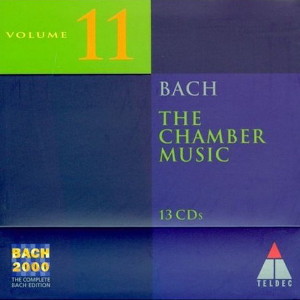 |
2 LP -
6.35339 EX - (p) 1976
|
 |
| 13 CD -
3984-25716-2 - (c) 1999 |
|
| Johann
Sebastian Bach (1685-1750) |
|
|
|
|
|
|
|
| Kammermusik - 6 Flötensonaten |
|
|
|
|
|
|
|
Sonata h-moll für Flöte und
Cembalo, BWV 1030
|
|
15' 49" |
A |
| - Andante |
7' 02" |
|
|
- Largo e dolce
|
3' 02" |
|
|
| - Presto |
5' 45" |
|
|
| Sonata A-dur für Flöte und
Cembalo, BWV 1032 |
|
12' 21" |
B1 |
| - Vivace (Rekonstruktion
Herbert Tachezi) |
5' 16" |
|
|
- Largo e dolce
|
2' 48" |
|
|
- Allegro
|
4' 17" |
|
|
| Sonata G-dur für Flöte,
Violine und B.c., BWV 1038 |
|
7' 32" |
B2 |
- Largo
|
3' 06"
|
|
|
| - Vivace |
0' 48" |
|
|
| - Adagio |
2' 18" |
|
|
| - Presto |
1' 20" |
|
|
| Sonate e-moll für Flöte und
B.c., BWV 1034 |
|
14' 15" |
C |
- Adagio ma non tanto
|
3' 16" |
|
|
| - Allegro |
2' 37" |
|
|
- Andante
|
3' 05" |
|
|
| - Allegro |
5' 17" |
|
|
| Sonata E-dur für Flote und
B.c., BWV 1035 |
|
11' 33" |
D1 |
- Adagio ma non tanto
|
2' 13" |
|
|
| - Allegro |
3' 15" |
|
|
- Siciliano
|
2' 53" |
|
|
- Allegro assai
|
3' 12" |
|
|
| Sonata G-dur für 2 Flöten und
B.c., BWV 1039 |
|
12' 35" |
D2 |
- Adagio
|
3' 32" |
|
|
| - Allegro ma non presto |
3' 38" |
|
|
- Adagio e piano
|
2' 25" |
|
|
| - Presto |
3' 00" |
|
|
|
|
|
|
| Leopold
Stastny, Querflöte (A.
Grenser, um 1750) |
|
Frans
Brüggen, Querflöte (Kopie
nach Hotteterre von F. v. Huene,
Boston), BWV 1039
|
|
Alice
Harnoncourt, Violine
(Jacobus Stainer, Absam 1665), BWV
1038
|
|
| Nikolaus
Harnoncourt, Violoncello
(Andrea Castagneri, Paris 1744) |
|
| Herbert
Tachezi, Cembalo (Martin
Skowroneck, Bremen 1973, in
französischer Bauweise; nach
italienischen Vorbildern BWV 1039) |
|
|
Luogo
e data di registrazione
|
Sankt
Georgen im Attergau
(Austria) - 1975
Vienna (Austria) -
marzo e aprile 1968 (BWV 1039)
|
|
Registrazione
live / studio
|
| studio |
Producer
/ Engineer
|
-
|
Prima Edizione CD
|
Teldec
"Bach 2000" - 3984-25716-2 - (13 cd) -
75' 35" - (c) 1999 - ADD
|
|
Prima
Edizione LP
|
Telefunken "Das
Alte Werk" - 6.35339
EX - (2 lp) - 35'
42"
+ 38'
23"
- (p) 1976
|
|
Note
|
Il
volume 11 della "Bach 2000" contiene 13
cd's. Le Sonate per Flauto sono
contenute nel cd 10 (tracce 1-22).
La registrazione della Sonata
BWV 1039 è la stessa già edita nel 1969
Telefunken
SAWT 9536-A.
|
|
|
Remarks on
the performance
|
In
all three movements numerous
articulation slurs were
supplemented and clarified.
Trills supplemented in the
first movement bars 26, 58,
90 (harpsichord), 112, 119.
Trills in the last movement
bar 91.
BWV 1032: The first
movement of this
sonata has unfortunately
been handed down only in
mutilated form since, in
order to save paper, the
work had been written on the
lines left over from other
compositions; about just
under half of this movement
fell victim to the “orderly”
cutting up of these pages.
Herbert Tachezi
reconstructed as faithfully
as possible in Bach’s style
the missing section, the
approximate length of which
can be concluded from the
number of cut off lines. -
The articulation, in
particular the semiquavers,
was completely supplemented
in accordance with other
Bach works which have come
down to us with precise
articulation signs.
In the second movement
the articulation merely had
to be clarified, because
Bach very frequently wrote
large articulation slurs
where he actually wanted
subdivided slurs. This
practice can be observed in
particular with orchestral
pieces with autograph parts:
short slurs accurately show
the desired articulation-
longer slurs more or less
indicate: “articulation must
be effected with binds
here”, perhaps with
reference to parallel
passages, to other parts
played accordingly or to the
general customary practice.
As, for instance, the first
bar:

Trills were supplemented
(bars 7, 10, 25, 35, 36).
In the third movement
the entire articulation
slurs were supplemented.
Trills (bars 12, 22, 44, 100,
110,117,
159, 173, 235, 247, 254).
BWV 1034: This sonata
was played with the cello to
bass duplication. The
articulation slurs of the first
movement were
minimally supplemented. In
the second movement
all the articulation slurs
were supplemented. Trills
(bars 28, 32). In the third
movement long slurs
were clarified, some of them
supplemented. In the fourth
movement some articulation
slurs were supplemented. Bar
42 (seconda volta)
3rd note in the bass a, not
a-sharp; bar 50, 3rd note in
the bass c’ not c’-sharp.
Trills in penultimate bar.
BWV 1035: This sonata
was played with the cello to
bass duplication. In the
first movement a few
articulation slurs were
supplemented. Minor
supplementations also in the
seconnd, third and fourth
movement.
BWV 1038: The violin
was played according to the
repitched part. Violin
tuning:

The reason for the deeper
pitching of the two upper
strings is the undoubtedly
better relationship to the
transverse flute which
sounds extremely gentle in
the lower position. The
articulation in this trio
sonata and also in BWV 1039
was carried out analogously
to the flute sonatas.
Nikolaus
Harnoncourt
English
translations by Frederick
A. Bishop
|
|
Nikolaus
Harnoncourt (1929-2016)
|

|

|
|

